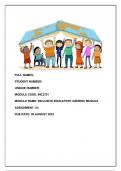Exam (elaborations)
PCA Exam Questions with A+ Graded Answers Latest Update
- Course
- Institution
PCA Exam Defoliants Defoliation Leaf loss or leaf absicisson. In cotton production, it usually refers to leaf loss associated with application of a chemical that injures the leaf. Defoliation can also occur through natural leaf maturation and senessence, particularly with cooling weather after bo...
[Show more]












